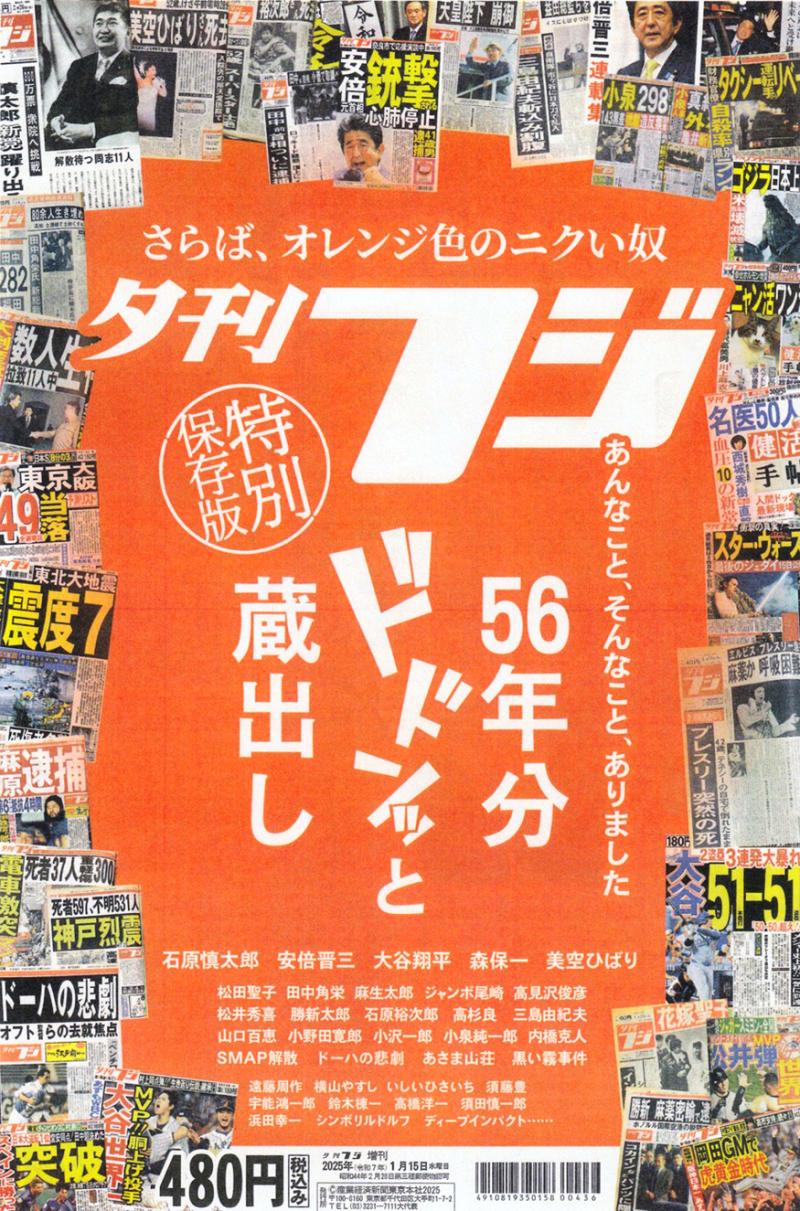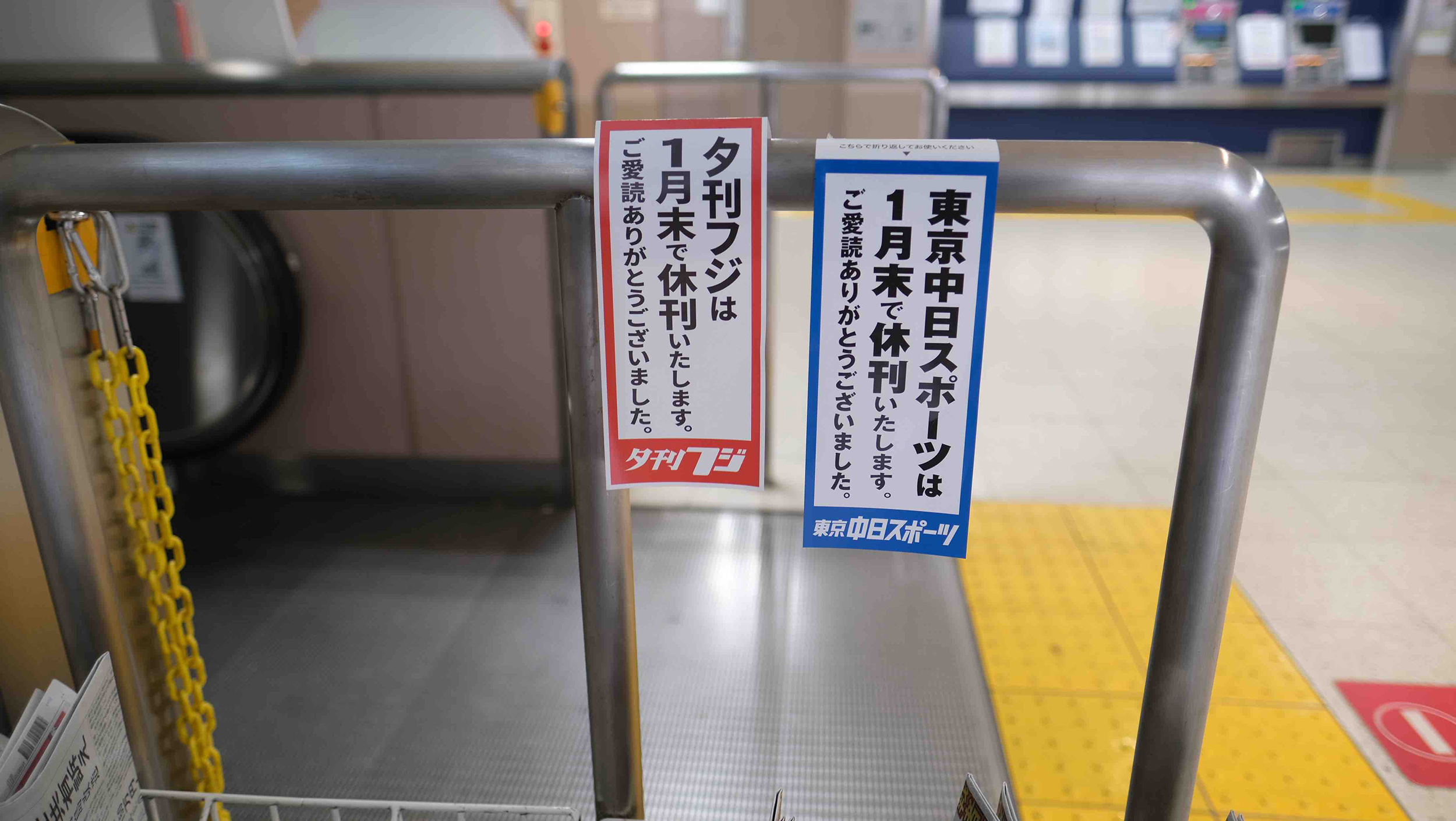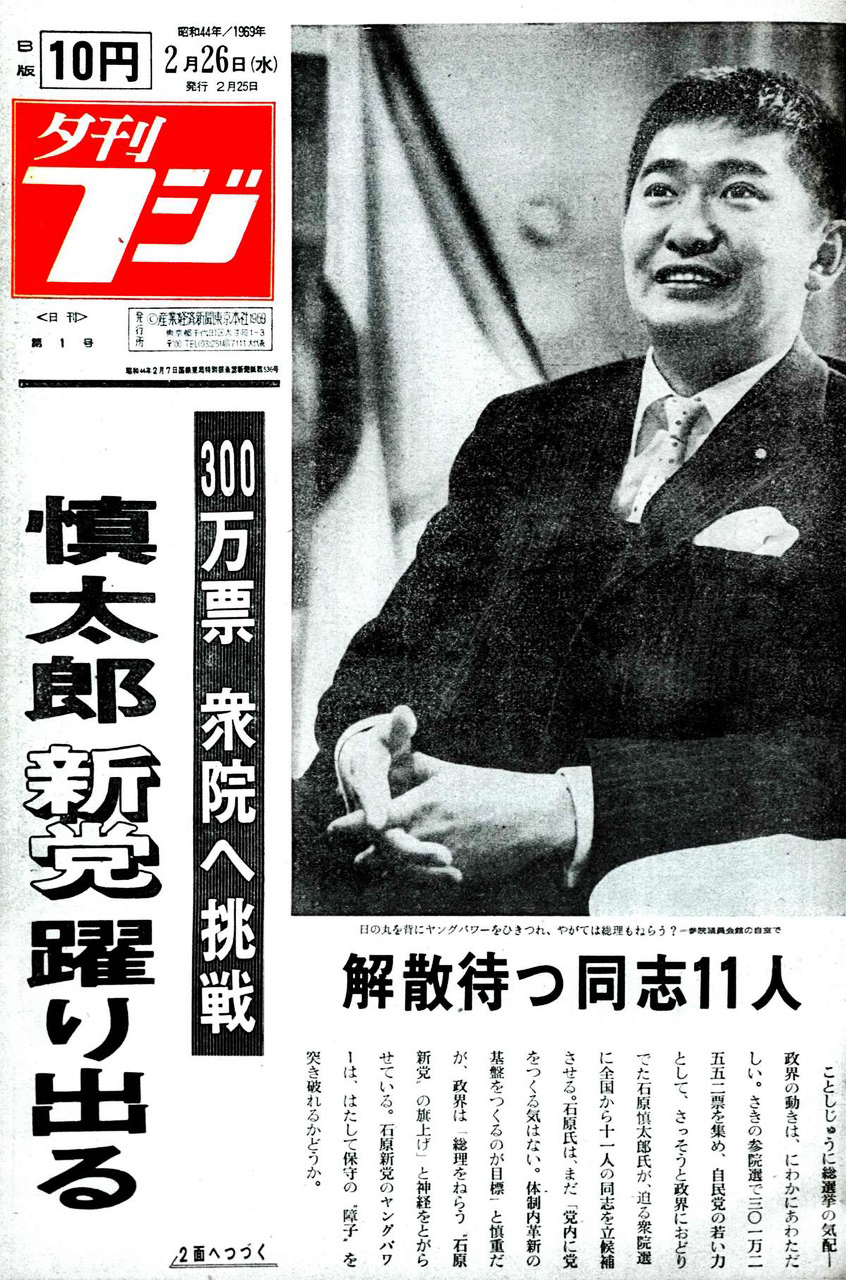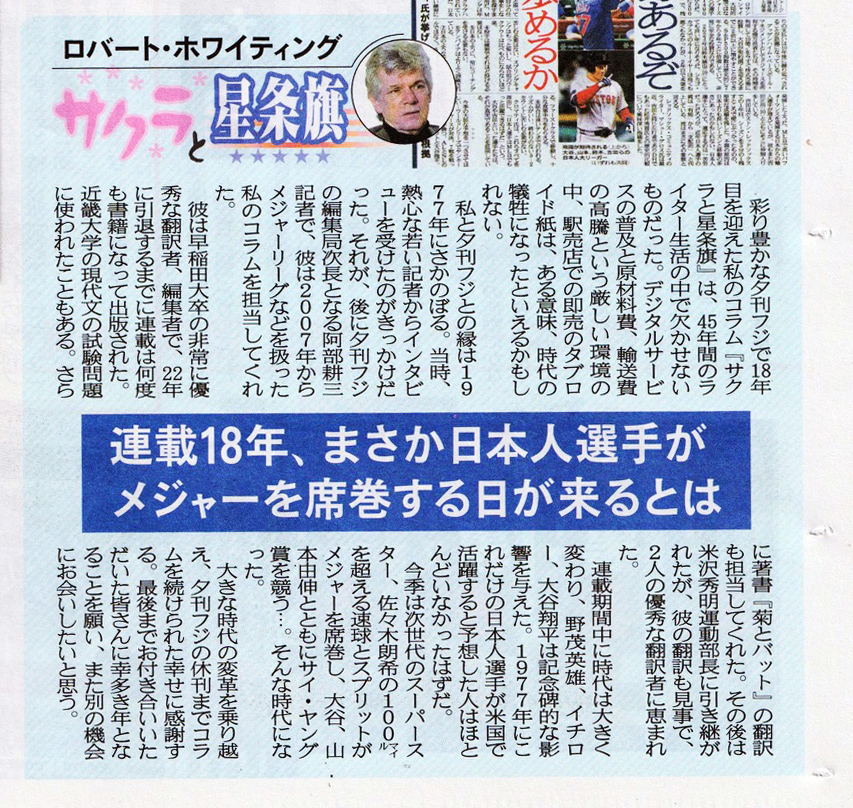Issue:
February 2025
The tabloid newspaper Yukan Fuji ends publication after 56 years

By virtue of his relatively tall (188cm) stature, this writer easily lapsed into the practice of nusumi-yomi – literally “theft reading”, or perusing other people's reading matter on rush-hour trains. Along with saving money, this pastime proved an effective way to acquire the latest news, while helping to expand my Japanese vocabulary.
Whenever I spotted unfamiliar words I would jot them down and later ask co-workers to explain their meanings. They frequently found my queries embarrassing, particularly when the terms in question came from a headline in the Yukan Fuji.
The headlines were easy to read, even from a distance, because most were about the size of the top lines on an eye chart. I fondly remember one chuckle, from a headline that screamed in 48 points, パンダ、やった! (panda, yatta! the pandas did it!), accompanied by a grainy photo of two pandas engaged in an act of procreation. This was enough to make frontpage headlines in the late 1970s, not long after a pair of pandas took up residence in Ueno Zoo.
Alas, those colorful, super-size headlines will appear no more. Last October, Fuji's parent organization, the Sankei Shimbun, announced it would suspend publication of its evening tabloid, effective January 31, 2025. Concurrent to Yukan Fuji's closure, the Chunichi Shimbun announced suspension of Tokyo Chunichi Sports, but with one key difference: Yukan Fuji's web site, Zakzak.co.jp, will also be terminated, while the Tokyo Chunichi Sports will continue being published electronically.

To many, the announcement did not come as a great surprise. As far back as September 2007, Business Inside reported: "As the baby boomers, who are the core readership, begin to retire en masse, evening newspapers have been experiencing a continuous decline in circulation, and Fuji-Sankei Group's Yukan Fuji has finally fallen into the red. There is speculation that the paper will take drastic measures, including suspending publication."
The article noted that a dozen years earlier, when Aum Shinrikyo's toxic gas attack on the Tokyo metro dominated the news, Yukan Fuji had boasted daily sales of around 400,000 copies (the claimed "official" figure was 1.5 million copies). In addition to the retirement of the baby-boomer generation, the paper was also losing young readers to free newspapers and magazines, and was facing sluggish demand. It has been mocked with derogatory comments, described as an evening newspaper bought for ¥120 at a railway station kiosk by uncool middle-aged people.
Recently, JR East and other companies have accelerated the removal of kiosks on station platforms, and the sharp decline in sales outlets has further aggravated the situation, the article said. Actual sales have recently fallen to the 100,000 mark, putting the paper in a critical situation.
"It will be difficult to maintain our readership if we are unable to keep up with changes in reader structure and sales channels," the Sankei Shimbun management was quoted as saying in the Business Inside article. Among the various reform proposals were revamping the content to appeal to a younger readership. But the tabloid’s management thought it would be difficult to create a paid evening paper that would appeal to young people accustomed to free papers, and any drastic changes could alienate existing readers.
It was also said that a plan had been floated to acquire rival tabloid Nikkan Gendai to create Japan’s sole evening tabloid, but this was rejected, with the argument that "even if two dwindling evening papers join forces, things will wind up back to where they were".
Citing an unnamed Sankei Shimbun executive, it appeared that plans would continue "to eventually to cease publication", but for the time being was decided to get by with forcing out senior editors and other cost-cutting measures.
The reason behind the postponement of radical reform, it was explained, was that if Yukan Fuji were able to halt the system of paying royalties (of about ¥2 billion yen per year) to the Sankei, it would achieve profitability on its own. Sankei's ordinary profit for the 2006 fiscal year was ¥3 billion, down 35% year-on-year. Like many in the newspaper industry, it had been hit by a double whammy of falling circulation and declining advertising revenues. To prevent the Sankei itself from falling into the red, the newspaper hoped that Yukan Fuji would overcome its difficulties through restructuring.
Four years after the above article, the February 11, 2011, issue of Shukan Bunshun magazine ran a story headlined “The shock of cutting staff in half: Sankei wields the axe to restructure the Yukan Fuji.”
"The Yukan Fuji, published by the Sankei Shimbun, one of the big three evening newspapers alongside Tokyo Sports and Nikkan Gendai, will undergo major restructuring effective February 1,” the article said. “Those involved are shocked by the restructuring, which could mean cutting staff in half and potentially even ceasing publication.
"From the current regular staff of about 50, only about 25 will be cut. Only the horse racing section will remain fully staffed, with personnel in the entertainment, politics, economics, and layout departments to be cut in half.
"We have had a tradition since the beginning of publishing that we would put in live news in the morning," a rank-and-file reporter at Yukan Fuji was quoted as saying. "But with the same number of pages and half the staff, it will be almost impossible. The higher-ups are saying crazy things like, 'Compete with your ideas,' but I think that's stupid."

The Yukan Fuji staff, Shukan Bunshun continued, would be transferred to the Sankei Shimbun's sales department, political department, economics department, the Sankei Sports, and other jobs.
"However, they are all people who have toiled under the banner of the Yukan Fuji, so they have little sense of affinity with the Sankei Shimbun. For them, it's going to be hell if they leave, and hell if they stay."
The executive who announced the changes at the editorial department was said to have been in tears.
The Yukan Fuji had cut a quarter of its staff in a restructuring just three years earlier, in 2008. “The profits are sucked up by the Sankei Shimbun itself, so no matter how much it earns on its own, what's left is just a drop in the bucket," it was explained.
An unnamed business writer was quoted in Shukan Bunshun as saying: "What's more, its circulation, which was over 200,000 copies until a few years ago, has fallen below the break-even point of 130,000 copies. This is due to the redesign of the layout and free online distribution of articles, which was spearheaded by the president of the Sankei Shimbun itself, who wanted to 'make it an evening paper that women and children can read. That move proved to be unfortunate."
Another reporter who was transferred also expressed his resentment, saying, "In the first place, Business i and Sankei Express, which were operated by Sankei's president Nagayoshi Sumita himself, are performing much worse. They targeted Yukan Fuji because the parent company's executives have no affection for it. The reason they kept this restructuring secret until the last minute was probably because they needed to demonstrate to their main bank as if they had taken a major axe to the organization.
"If they care more about the bank than their readers, then a drop in morale and a loss of readers will be inevitable," Bunshun quoted the reporter as saying.
Then, 13 years after the Bunshun article, came the announcement that the newspaper would be folding.
Eulogizing Yukan Fuji in the Sunday Mainichi magazine of February 2, former editor Hiromi Nakamoto, who had joined the paper's Osaka bureau in 1987, recalled his years there. "Of course we had to adhere to guidelines, but we always kept in mind the need to keep up with the changing times. What could we do to get readers to lay out their coins to buy a newspaper? In those days we'd be totally focused on that.
"Especially in the past few years, we'd been strongly pushing ideas like 'This is the best direction for Japan,' or 'There's something wrong about this,' making our stance clear. Evening newspapers have been a media sold mainly at railway station kiosks," he said, with 30 to 50 copies fanned out in a conical shape figuratively described as takenoko (bamboo shoots). The size of the "bamboo shoots" were determined by whether that particular issue ran a scoop or not.
In the good old days, it was also common to see the kiosks festooned with elongated strips of paper called mae-dare displaying the day's top headlines.
"Every morning the editor would meet with the sales manager and directors for detailed discussions about why the previous day's issue had – or not had – sold well," Nakamoto related in Sunday Mainichi. "Staff who worked in the sales department would listen to what the people who worked at the kiosks told them, and say to us, 'That kind of headline won't sell!' 'Can't you use expressions with greater impact?' and so on.
"Those quarrelsome meetings were a regular part of our morning regimen," he added.
At least one FCCJ member, Robert Whiting, will be affected personally by the tabloid's demise.
"I was saddened to see the end of Yukan Fuji," Whiting said in an email. "This brings an end to over a half century of a vital presence at train station kiosks as this newspaper fell victim of the spread of digital services and rising costs for raw materials and transportration."

Back in 2007, Whiting had been approached by the tabloid to write a weekly column, mostly about baseball, titled Sakura to Seijoki (cherry blossoms and the Stars and Stripes).
"For the next 18 years that's what I did," he wrote. "Materials from those columns wound up being published in three of my books.
"Actually, my relationship to Yukan Fuji goes back even longer, all the way back to 1977 when I was interviewed by an enthusiastic young reporter named Kozo Abe, a Waseda graduate, who wrote a feature article about my new book The Chrysanthemum and the Bat. Years later Abe-san also translated my columns until his recent stroke and retirement. He is a good man and a good friend."
Whiting viewed Yukan Fuji as a "conservative rag that was the polar opposite of its evening tabloid rival Nikkan Gendai, which was anti-LDP through and through. I considered them the Japanese equivalents of the New York Post and the New York Daily News.”
In his parting column on January 28, Whiting shifted his focus from sports to international relations, ending on the note that in a year that's already proceeding to be chaotic, "…the future of healthy Japan-U.S. relations is also uncertain".
In the runup to its closure, on January 15, Yukan Fuji issued a special 36-page keepsake edition in which editor Masashi Yano delivered this parting note: "One sobriquet that had been frequently applied to Yukan Fuji was orenji iro no nikui yatsu (the ‘orange deplorable’)" wrote Yano. "It was a nickname we wore as a badge of pride."
Yano saw his newspaper as a "media icebreaker" that forged ahead, breaking up "frozen taboos”.
"It's sad to see its history of 56 years come to an end," he wrote. "However, I think that suspension of its publication will see the members of Yukan Fuji hunkering down as they prepare to confront their next challenge. I hope readers will keep their eyes peeled for the future struggles of these people, who will carry on with the paper's spirit that embodied creativity and confronting new challenges."
Mark Schreiber is the author of Shocking Crimes of Postwar Japan (Yenbooks, 1996) and The Dark Side: Infamous Japanese Crimes and Criminals (Kodansha International, 2001).

